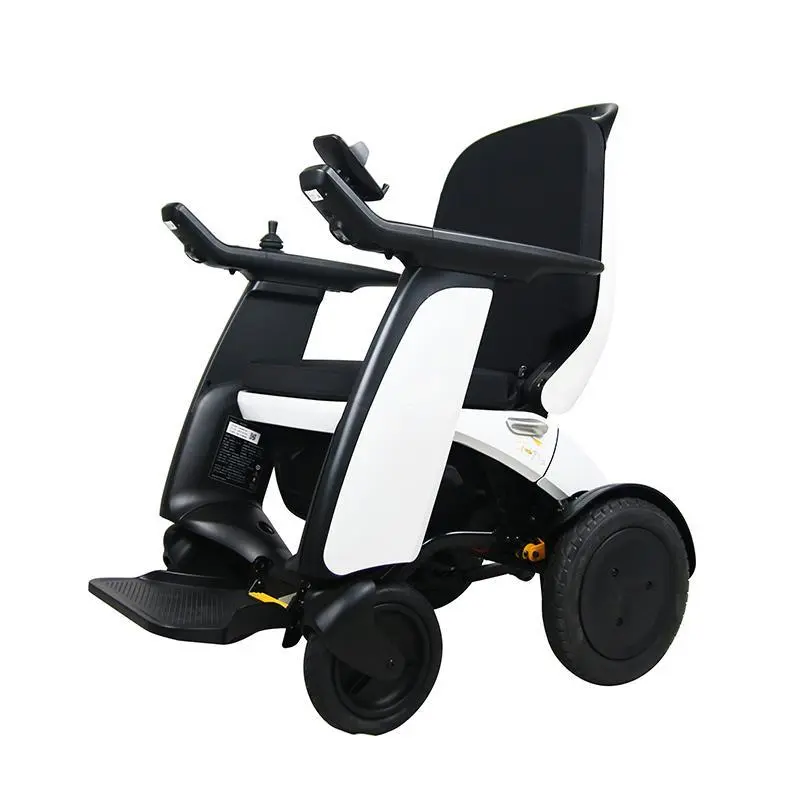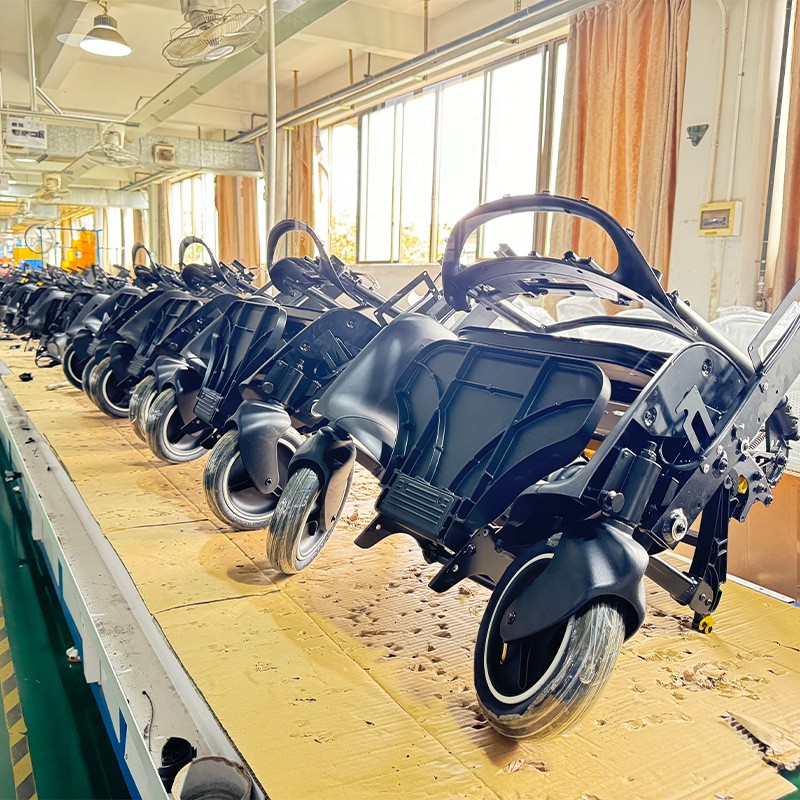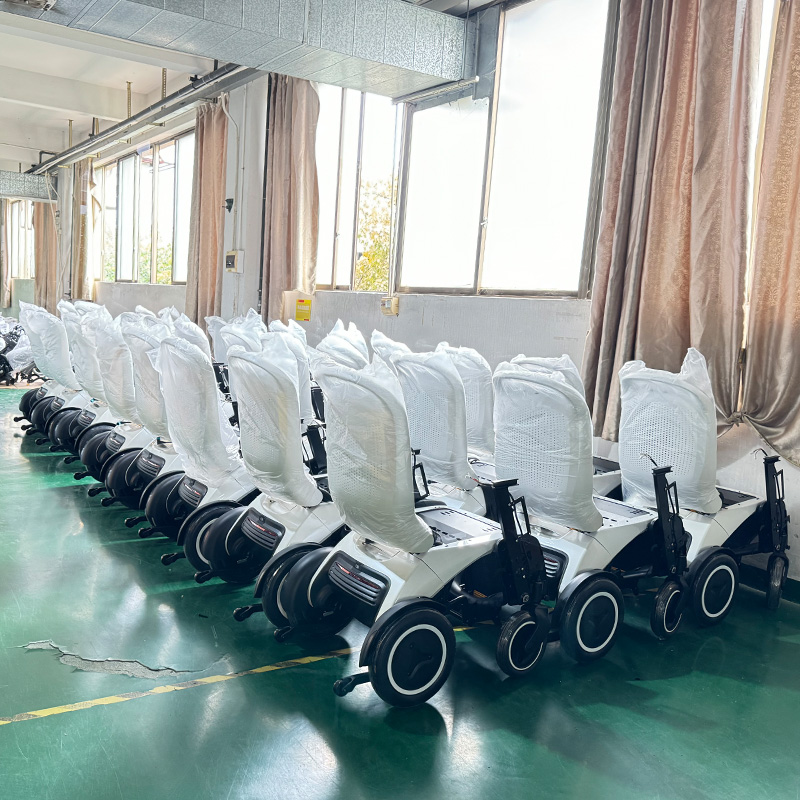Compared to traditional manual wheelchairs, electric wheelchairs offer advantages such as ease of control, reduced effort, and a wide range of functions. They are popular with the elderly, people with disabilities, and those recovering from surgery. However, as electronically powered devices, power wheelchairs pose a particular concern for users regarding water resistance.
Particularly during the rainy season, in humid areas, or when users spend extended periods outdoors, questions such as "Can electric wheel chairs withstand rain? What happens if they get wet?" are increasingly common.
This article will provide a professional and systematic discussion of electric wheel chairs, including structural analysis, potential hazards of moisture, and precautions for use. This will help users fully understand the effects of moisture on electric wheelchairs and enhance their safety awareness.

Electric Wheelchair Structure and Electronic Systems
A complete electric wheel chair typically includes the following core systems:
• Battery System: Typically a lithium or lead-acid battery, it provides the power source.
• Motor System: Responsible for driving the wheelchair forward and backward, steering, climbing, and other movements.
• Control System: This includes the joystick, controller board, and circuit board, acting like a "central nervous system," processing signals and issuing movement commands.
• Charging system: Battery charging port, power cord, power management module, etc.
• Electromagnetic brake system: Provides automatic braking when the wheelchair is released.
• Wiring: Wires, sensors, and connector modules throughout the wheelchair.
All of these systems rely on electronic components for automatic control and power. Therefore, contact with water is highly likely to cause problems such as short circuits, corrosion, poor contact, and even malfunction.

Why are electric wheelchairs susceptible to getting wet?
1. Electronic components are easily damaged by moisture
Water is conductive. Rainwater or moisture seeping into the interior of an electric wheelchair, particularly areas like the controller, battery, and circuit boards, can cause:
• Short circuits;
• Component burnout;
• Controller failure or malfunction;
• Sudden stops or loss of control of the wheelchair.
2. Metal parts are susceptible to rust and corrosion
Electric wheel chairs are mostly made of metal (such as steel and aluminum alloy). Prolonged exposure to moisture or rain can cause:
• Rusting where the paint on the frame is damaged;
• Seizure of the shaft, wheel hub, and brakes;
• Loosening or breaking of screws and connectors due to rust;
• Reduced overall wheelchair load-bearing capacity and safety.
3. Batteries are at high risk of moisture
Lithium batteries, in particular, have complex structures and are susceptible to environmental influences. Moisture intrusion can cause:
• Internal short circuits;
• Charging failure;
• In severe cases, fire or explosion.
4. Increased user health risks
Prolonged moisture in the seat, armrests, and cushion of a power wheelchair can also lead to:
• Skin infections;
• Bed sores;
• Imbalanced body temperature regulation, and other health risks.
Therefore, electric wheelchairs are "really afraid of getting wet," and strict precautions must be taken.

What environments are likely to cause electric wheel chairs to get wet?
1. Going out in the rain: Walking outdoors without protective gear.
2. Wet terrain: Areas with standing water, such as concrete, grass, beaches, and muddy grounds.
3. Home mistakes: For example, sitting down directly after showering, or not wiping up water stains on the floor.
4. Accidental spills: For example, spilling drinks or soup on the seat or controls.
5. Improper care: Wetting the seat cushion due to incontinence or body fluids not being cleaned promptly.
These seemingly everyday situations can cause irreversible damage to your power wheelchair.
Common Problems and Symptoms of Electric Wheelchairs When Wet
If your electric wheelchair has been exposed to water, moisture, or water, the following problems may occur:
Electric wheelchair problem types | Common Symptoms |
| 1. Controller failure | Unresponsive control panel, malfunctioning buttons, ineffective switches, false alarms |
| 2. Motor malfunction | Increased noise, power loss, jerky movements, inability to move forward or turn |
| 3. Battery failure | Unable to charge, reduced battery life, false battery level reports, charger alarms |
| 4. Brake system malfunction | Unable to brake, unstable coasting, electromagnetic brake failure |
| 5. Frame rust | Surface rust on structural components, loose connections, sticking joints |
| 6. Wiring aging | Poor contact, short circuit, burning odor, smoke coming from wiring |
What is the waterproof rating of your power wheelchair? Is it waterproof?
Most electric wheel chairs on the market are not fully waterproof; most only have basic splash and drip resistance (similar to IPX3 or IPX4). Even if some products claim to be "waterproof," this often refers to sealing the controller housing or connectors, and does not mean the entire device can be used in the rain or in water.
Remember:
• Waterproof ≠ Rainproof ≠ Washable ≠ Soakable
When purchasing, users should carefully review the product manual to understand the "IP rating" and carefully select the appropriate one based on the intended use environment.
What to do if your electric wheelchair gets wet? Emergency Procedure
If your electric wheel chair accidentally gets wet, immediately take the following emergency measures:
1. Immediately disconnect the power cord: Turn off the power and unplug the battery to prevent further damage.
2. Wipe away any moisture from the exterior: Use a dry cloth or paper towel to absorb any surface moisture, especially on the controller, joystick, and connectors.
3. Do not use immediately: Even if the wheelchair appears dry, moisture may still be present inside.
4. Air dry: Place the wheelchair in a well-ventilated area, out of direct sunlight, and allow it to dry for at least 24 hours.
5. Disassemble and inspect (recommended by a qualified professional):
• Open the battery compartment and electrical control box and inspect for water stains and rust;
• Clean and reseal the connectors;
• Replace any damaged wiring if necessary.
6. Contact the manufacturer or after-sales technical support: Have a professional repair technician assess any potential hazards.

How can power wheelchairs be waterproofed and moisture-proofed on a daily basis?
To prevent power wheelchair malfunctions due to water or moisture, the following protective measures are recommended:
1. Use a rain cover
Purchase a dedicated electric wheelchair rain cover or rain cape to protect the entire wheelchair from rain.
2. Controller waterproof cover
Add silicone protective covers to the control panel and joystick to prevent water intrusion.
3. Seal the battery compartment
Regularly check that the battery compartment cover is tightly closed to prevent water intrusion. If necessary, add waterproof strips.
4. Avoid water-related terrain
Try to avoid driving in muddy, puddled, or damp areas.
5. Store in a dry environment
Place your electric wheelchair in a dry, ventilated area at home that is free of mold and mildew.
6. Clean and maintain your wheelchair promptly
If spilled or in humid weather, clean and dry it immediately to prevent rust.
"Are electric wheelchairs afraid of getting wet?"
Yes, electric wheel chairs are indeed sensitive to getting wet!
While electric wheel chairs offer immense convenience, as complex electronic devices integrating batteries, motors, and control systems, their stability and safety are highly dependent on a dry operating environment.
As we've emphasized repeatedly throughout this article:
• Electric wheelchairs are indeed sensitive to getting wet. Prolonged exposure to moisture or accidental water ingress can have serious consequences, including malfunction, safety incidents, and even a shortened lifespan.
Therefore, every user, family member, or caregiver should be aware of basic device protection to avoid even the slightest negligence that could impact quality of life or even lead to unexpected risks.
While enjoying the convenience of technology, it's also important to invest in daily maintenance and environmental protection to ensure that electric wheel chairs truly become safe and secure companions.
What kind of buyers typically work with your company?
We primarily serve medical distributors, eCommerce brands, wholesalers, clinics, and healthcare procurement departments. Many of our clients seek high-quality Chinese suppliers to lower costs without compromising on compliance.
We offer discount pricing, volume promotions, and factory-level service to meet the needs of businesses sourcing power wheelchairs, beds, shower chairs, and walking aids from a reliable partner.










